Is BANT Still Effective in 2023? [Pros, Cons, Alternatives]
Casey O'Connor
BANT is a lead qualification framework made popular in the 1950s. It was widely used for decades but has become less prevalent as sales has changed over time to become more buyer-focused with longer sales cycles.
But despite sellers’ misconceptions, BANT can still be a very effective lead qualification tool, even in today’s technological sales world in which the buyer has most of the control.
In this article, we’ll go over everything you need to know about BANT, including how to use the framework, its pros and cons, how to adapt it for 2023, and a few alternatives to explore.
Here’s what we’ll cover:
- What Is BANT?
- Is BANT Still Effective in 2023?
- How to Use the BANT Framework to Qualify Leads
- BANT Lead Qualification Questions
- Pros and Cons of BANT
- BANT Alternatives
What Is BANT?
BANT is a lead qualification framework that helps sales reps determine which prospects represent a good fit for their offer.
The acronym BANT stands for Budget, Authority, Need, Timeline. 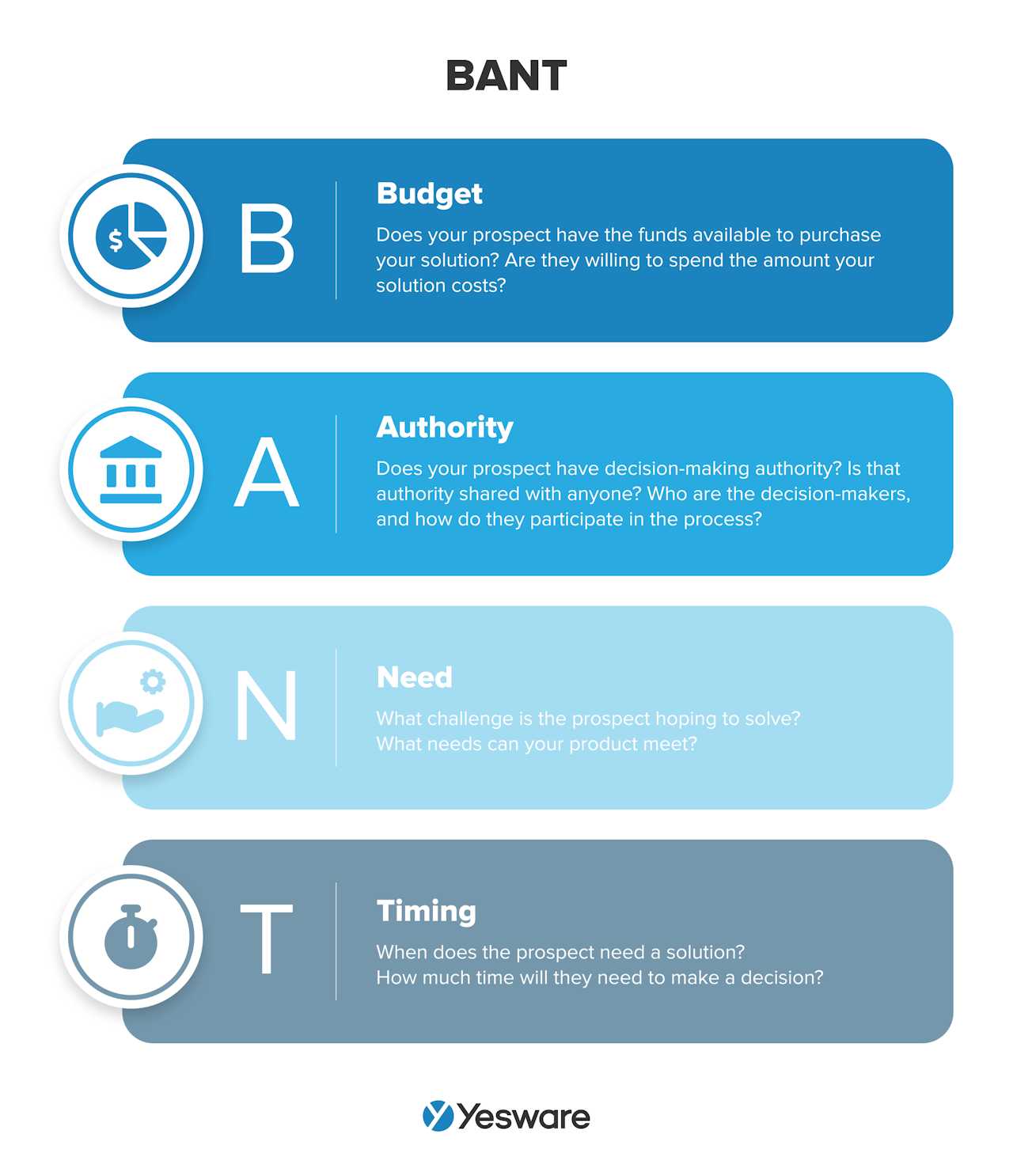 The BANT framework was developed in the 1950s by the sales team at IBM.
The BANT framework was developed in the 1950s by the sales team at IBM.
At the time, each successful IBM sale required months, sometimes even more than a year of a salesperson’s time before it closed. BANT was developed as an attempt to shorten the qualification process and determine who would benefit from an IBM product much earlier on in the process, so that sales reps could focus on the right leads from the start.
These IBM reps used the approach in sales conversations to learn more about a prospect’s budget, the authority they had in the purchasing process, how much they truly needed a solution, and how urgently their problem needed to be solved.
The BANT framework has stood the test of time, despite what some more modern sales reps might believe, because it highlights four of the most important factors when it comes to purchasing decisions. BANT can be very effective in making the overall sales process more efficient.
BANT Explained
Budget
Some of the most common sales objections that reps encounter involve money or budget concerns. These can be one of the hardest objections to overcome, so the BANT framework has sales reps approach the topic right away.
This tactic can have a big payoff — some studies have shown that win rates improve by about 10% when budget is discussed within the first sales conversation.
It’s important that sales reps understand that when they qualify for budget, they need to learn more about a prospect’s/organization’s willingness to spend a certain amount as much as their ability. Don’t become complacent around budget just because you’re talking to an organization with impressive revenue; make sure you understand how much the prospect thinks they want to spend, in addition to what they have in their business account.
Authority
When sales reps qualify a prospect for authority, they work to determine their rank or status in the decision-making process.
Unlike the sellers at IBM in the 1950s, today’s sales reps are often required to work with entire decision-making teams — not just a single person. This can make lead qualification much more complex.
You may not talk to the ultimate decision maker (usually a C-suite executive that provides the final sign-off) until later in the process, but it’s important that you connect with someone who’s at least involved in the discussion. Research shows that sales conversations that exclude any kind of decision-maker are about 80% less likely to close.
Need
Sales reps also need to spend time qualifying prospects based on how much they actually need the solution you’re offering.
Reps should consider “need” in terms of both quality (How well does the offer meet their needs?) and quantity (How much do they really need it?). They will also want to ask questions to better understand whether the answers to those questions are the prospect’s individual opinion, or if the prospect is speaking on behalf of the entire decision-making team.
Timing
When sales reps qualify for timing, they attempt to uncover how urgently a prospect/their organization needs to find a solution. Factors that may play into a team’s timing include (but are not limited to):
- How many steps are in the decision-making process
- How many decision-makers are required
- How much is the problem currently costing them
- How many other solutions they’ve already tried
Sometimes prospects struggle to define their timeline. In some cases, sales reps can help prospects figure out their timing by identifying an upcoming event or deadline that has important results tied to it.
An organization might, for example, want to triple their revenue by the same time next year. Maybe they have an upcoming trade show in six months and want to improve their close rate by 8% before that date. Prospects may not always be able to define timing when it comes to an actual purchase, but most can identify an important upcoming deadline, which can help you understand their most pressing timing concerns.
Most sellers consider a lead well-qualified if they meet at least three of the four BANT criteria.
Is BANT Still Effective in 2023?
Although BANT is one of the most well-known qualification frameworks in just about every sales industry, it’s not one of the more popular ones today.
In fact, many people in sales have definitively archived BANT, categorizing it as obsolete, and prefer to rely on the newer qualification frameworks.
Many sales reps believe that BANT doesn’t accurately reflect the many nuances of the B2B decision-making process.
Budget
In terms of budget, most prospects today make decisions under a totally different set of circumstances than potential IBM customers did in the 1950s.
Buyers back then were asked to shore up tens and even hundreds of thousands of dollars at once for brand-new, widely-unproven technology.
Today, buyers sign contracts for monthly payments of much smaller amounts. Their purchase may come out of operational expenses, rather than capital funds. The budget criteria are markedly different and feel less consequential at the moment of purchase.
Decision-Making
There are significant differences in authority considerations, too.
Back then, sellers usually worked with one buyer, and he was the sole decision-maker. Today, most B2B sales require 6 – 10 decision-makers, and many of them filter in and out of the sales process at various times throughout. The BANT framework doesn’t account for that (at least, not on its surface).
The needs of today’s buyers are also defined much differently than the needs in the 1950s. Nothing is black-and-white in sales today; everything has nuance.
Almost no prospects will be a “perfect” fit for your solution, so how will sellers decide whose needs are stronger? And how does BANT suggest sellers approach leads who really want their solution, but don’t necessarily need it?
Timeline
Timelines are more complicated now, too.
Although technology has made setting up new accounts, onboarding, and providing customer service easier than ever before, there are other factors that modern sellers have to contend with that can complicate even straightforward, fast purchases.
It’s no easy feat to coordinate the schedules of 6 – 10 people, and if organizations require all decision-makers to be present at sales meetings, completing purchases in a timely manner can be a challenge.
Technique
The truth is, though, that BANT started becoming defunct long before some of the newer frameworks hit the sales scene. The framework started losing its effectiveness when sales reps tried using it in bulk and treating it like a checklist, rather than a conversation guide.
BANT was never intended to be a box ticker for sales reps. Even the most skilled 1955 IBM sales rep would struggle to close deals if they walked in and asked the following:
- What is your budget for this purchase?
- Are you the decision maker?
- What exactly do you need in a solution?
- By what date do you need to make a purchase?
The IBM sales reps who developed BANT created it as a way to keep themselves on track as they navigated a thorough qualification conversation. It was designed as a reminder system to ensure sales reps asked about all four important factors before moving the deal to the next stage of the pipeline (or not).
BANT can still be used very effectively in 2023; you just have to know how to use it the right way. If sales reps use the framework to guide their conversations, rather than dictate them, BANT can help sellers build trust with buyers and better understand their needs.
Buyer Groups
Any sales rep can take the principles of BANT and update/expand them to meet the needs of today’s buyers.
When speaking about budget, for example, sales reps can shift away from discussions about cost, and more toward value delivered. Affordability is less important to today’s buyer than ROI. The more specific and tangible, the better.
And when finding out more about decision-making authority, sales reps can use BANT to dig a little bit deeper into different roles they might encounter among the team.

When determining the need, reframe BANT by moving away from the basic needs, and dig deeper into the “why.”
And, when it comes to timelines, remember that you can work backward from desired events to learn more about when exactly they need to have a solution up and running.
How to Use the BANT Framework to Qualify Leads
The following steps will help you update your BANT framework approach for qualifying leads in 2023.
1. Create/Refine Your Ideal Customer Profile (ICP) And Buyer Personas
A thorough and accurate ICP — and a profile about each buyer persona you may encounter in the decision-making process — is the foundation of effective lead qualification. 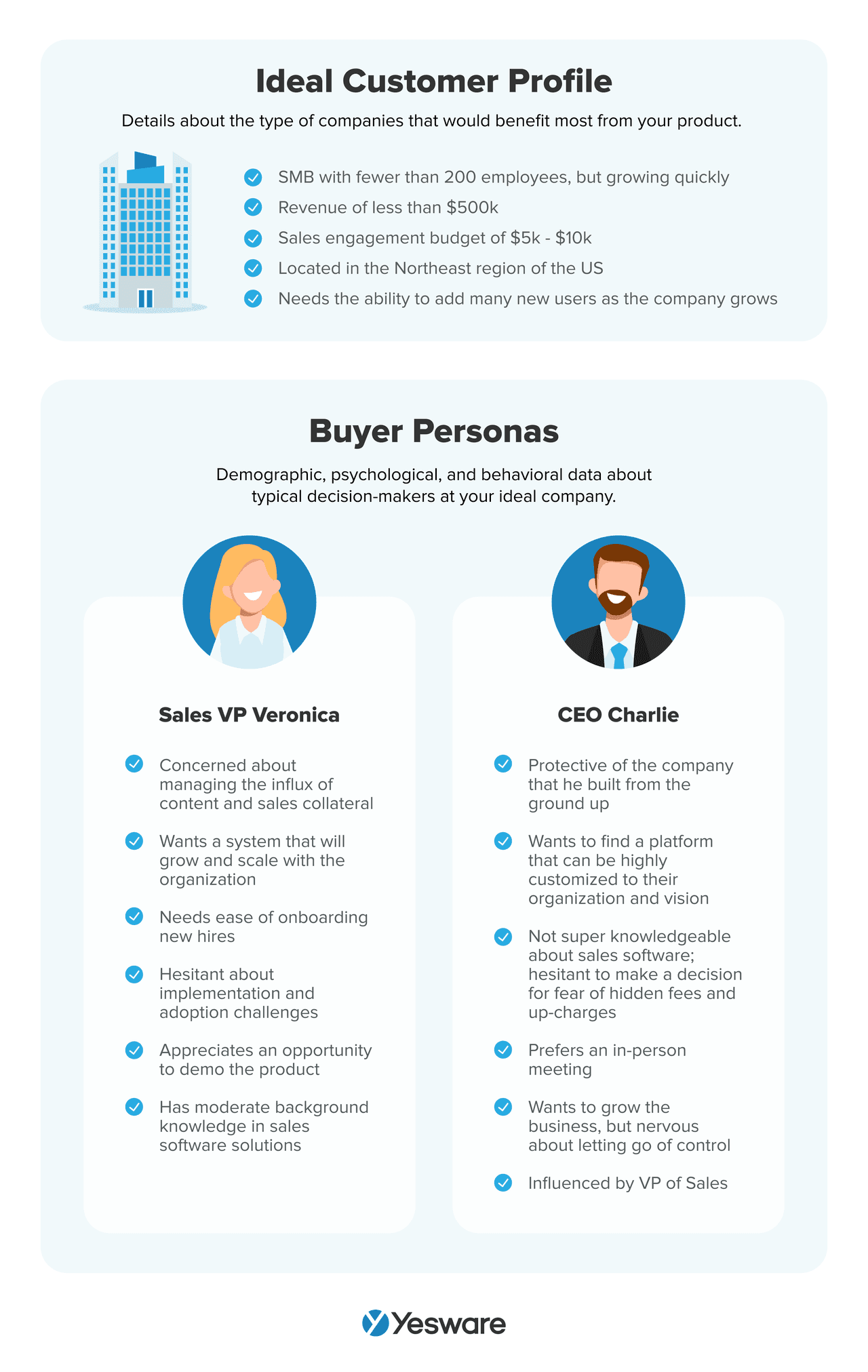 At a minimum, these profiles should contain the following information:
At a minimum, these profiles should contain the following information:
- Industry/vertical
- Company size (number of employees and number of customers)
- Annual revenue
- Monthly recurring revenue (MRR)
- Location
- Key challenges
- Pain points
- Needs
- Goals
- Tech stack details
Your ICP and buyer personas are living, breathing documents, and can and should be updated as you better understand your buyer.
2. Learn About the Prospect’s Budget
It’s important to take this step beyond the literal.
When using BANT in 2023, it’s not enough to simply ask the prospect how much they hope to spend. Budget concerns are about more than just a dollar amount.
Most salespeople who use BANT successfully in today’s sales world know that the budget portion of the conversation needs to revolve less around cost and affordability, and more around ROI and value.
3. Identify Stakeholders
To the best of your ability — without coming across as pushy, nosy, or dismissive — try to identify the different players on the prospect’s decision-making team.
Here’s another area where a lot of failed BANT users go wrong: this isn’t a yes or no question. Do not approach the prospect with a mindset of needing to find whether or not they’re ultimately in charge. You’ll need to take a more subtle approach in learning more about how the person with whom you’re conversing fits into the larger overall purchasing context.
Find out as much as you can about the entire decision-making team: their names, their job titles, how much influence they have in making decisions, how to best reach them, etc. Again, it’s of utmost importance to avoid sounding too intrusive. There’s a fine line between thorough research and crossing boundaries; sales reps need to take care to learn the difference.
4. Measure the Importance
Each prospect that enters the pipeline will have a different level of need for your product. Some need to purchase a solution urgently and may opt for yours out of convenience.
Others can afford to take more time, and will therefore consider other factors.
Sellers need to learn how to ask effective BANT questions that will highlight just how important this problem is to the prospect and their organization as a whole.
It’s also important in this stage to compare and contrast the prospect’s opinions and desires with those of their overall organization. Sometimes a prospect may be deeply impacted by a problem and have a strong need to solve it quickly, but the problem may not be as high of a priority for the rest of the decision-makers.
5. Prepare a Timeline for the Sales Process
Sellers should make themselves available according to the buyer’s timeline (unless, of course, they can’t deliver in the timeframe required — be transparent if you need more time than they have allotted).
Prospects may have an end date in mind, but they will likely still rely on you (consciously or otherwise) to design a roadmap to help them reach the end goal.
6. Use Digital Tools to Track Your Progress
Fortunately, the rise in sales technology makes it incredibly easy to track how well your lead qualification efforts are going. Here are five metrics that help sales reps measure the effectiveness of their lead qualification:
- Engagement rate
- Qualification rate
- Conversion rate
- Pipeline contribution
- Win rate
Tip: Stay organized in your prospect research with the free spreadsheet below.
 Free Template for Your Prospect ResearchThis customizable template will help you organize all prospect research in one place so you can quickly personalize outreach.
Free Template for Your Prospect ResearchThis customizable template will help you organize all prospect research in one place so you can quickly personalize outreach.BANT Lead Qualification Questions
Here is a non-exhaustive list of BANT lead qualifications to practice using with your team.
- How much do you currently spend on this problem/need?
- How much have you spent already trying to solve it?
- Based on metrics from clients with demographics similar to yours, we’ve calculated that your team is losing $X per [week/month/quarter/year] due to this problem. How does that compare to the budget you’ve allocated?
- Based on metrics from clients with demographics similar to yours, we’ve calculated that your team could potentially earn an additional $X per [week/month/quarter/year] by adopting our solution. How does that compare to the budget you’ve allocated?
- Which team is primarily responsible for this purchase?
- How much would it cost if you haven’t fixed this issue in five years? Think in terms of dollar amount and other resources (time, manpower, etc.).
- How much will price factor into your decision?
- Do you have a set budget for this purchase, or is it a range?
- Is cost or quality a higher priority for you?
- What ROI would make this purchase feel worth it for you?
- Do any other departments have influence over your department’s budget?
- Who will be the end user of the product? Are they involved in the decision-making process?
- When was the last time you made a similar purchase? How did the decision-making process go?
- This is normally the stage where the buyer brings in the [other stakeholders] to discuss or get additional perspective. Is there anyone you want to loop in at this stage?
- At some point the entire decision-making team will need to come together to find consensus. At what stage does this make most sense for your team? Whom do you plan to pull into the process and when?
- Will anyone else be included in this decision?
- When did you first realize that you had this problem?
- How have you already tried to address this problem?
- What are your top priorities at the moment? How do they align with your team’s goals?
- What are your team’s goals for the next month/quarter/year?
- What could potentially happen to your team’s goals if you don’t address this need?
- How would your life improve if this problem were solved?
- How have past purchases been implemented? Have decision-makers and C-suite executives been satisfied with past purchases?
- Are there any upcoming events/deadlines that you’d like to have a solution in place by?
- Working backward from the date you gave me, we’d need to finalize our agreement by [date]. Could that work for you?
Truthfully, just about every lead-qualifying question a salesperson could think of would probably fall under at least one domain of BANT. The key to this framework isn’t so much the questions themselves, but finding the right combination and flow of questions so that the conversation feels curious, insightful, and easy.
Pros and Cons of BANT
BANT is well-known and, therefore, a popular one for sales reps just learning how to qualify leads. It’s important that salespeople understand the pros and cons of using the BANT framework before they dive in.
Pros
One of the best things about BANT is that it’s easy to apply to just about any buyer persona and individual prospect. The framework is flexible, and any questions that are part of the process are easy to modify.
It also benefits sales teams because it helps keep everyone on the same page. All leads that go through a BANT lead qualification process will have a standard set of data attached to them, so that all sales reps know how to prioritize the leads in the pipeline.
Cons
There are also some downsides to the approach, though. As we mentioned earlier, a lot of people are disinclined to use BANT because of how long ago it was created; some assume that, due to its age, the framework is inherently outdated.
Some sellers also find BANT to be too seller-centric, with not enough focus on building relationships with buyers or providing value through the sales process.
BANT Alternatives
Fortunately, there are several lead qualification frameworks from which sellers can choose. BANT works well for many teams who choose to use it to its potential, but it’s okay to explore alternative options, too. Here are a few of the most common.
MEDDIC
The MEDDIC framework revolves around asking prospects specific questions related to the following categories. 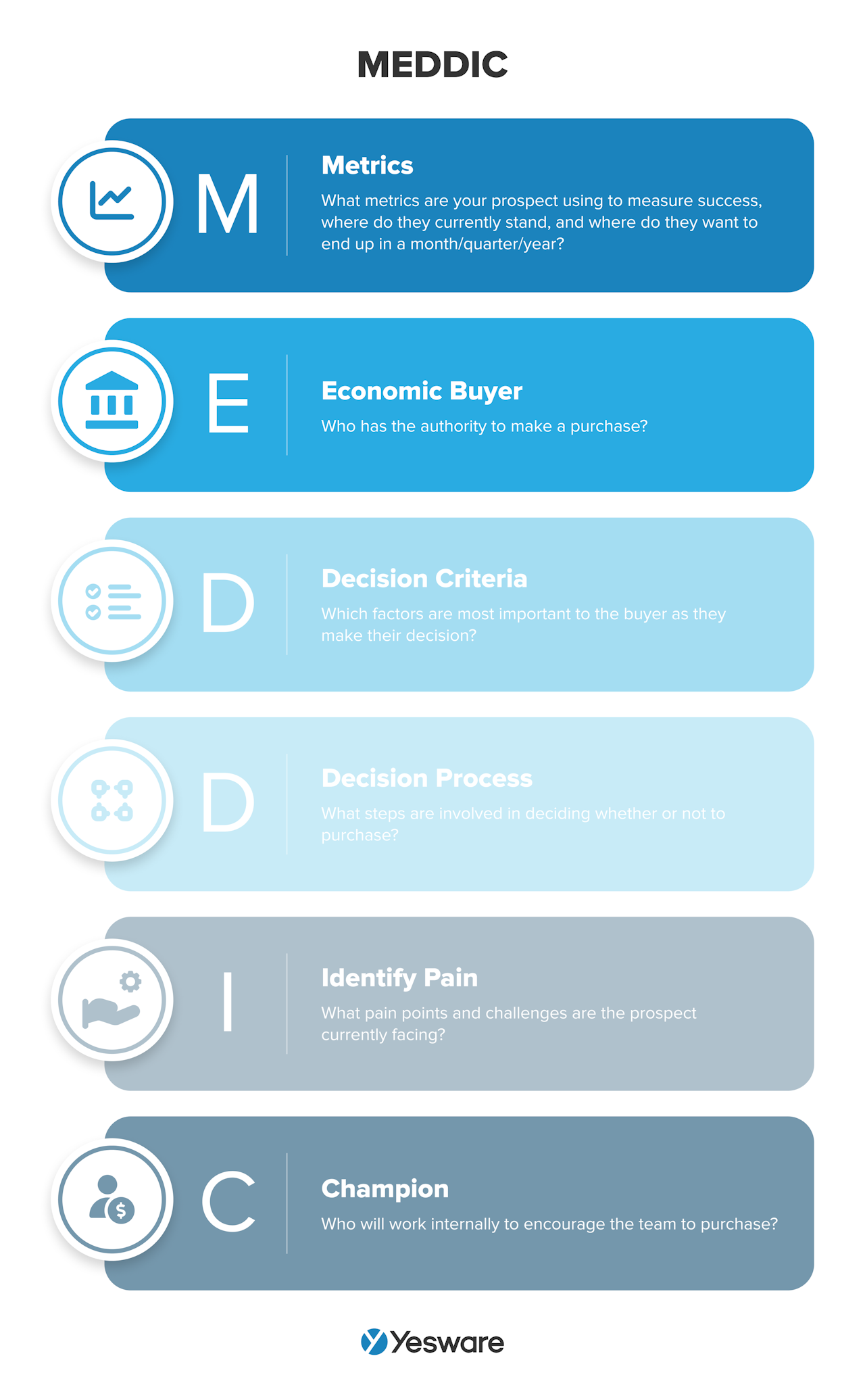 Here’s the MEDDIC acronym broken down:
Here’s the MEDDIC acronym broken down:
- Metrics: A salesperson using the MEDDIC framework needs to first find out about the buyer’s tangible goals or sales targets. Learn what metrics they’re using to measure success, and find out more about where they currently stand — and where they want to end up in a month/quarter/year.
- Economic Buyer: Just like BANT, MEDDIC asks sellers to find out more about who has the authority to make a purchase.
- Decision Criteria: Here’s where MEDDIC branches off a bit from BANT. This framework helps sellers uncover which factors are most important to the buyer as they make their decision.
- Decision Process: To round out the decision-making data, the second “D” in MEDDIC asks sellers to learn more about the steps involved in deciding whether or not to purchase. This framework covers the who, the what, and the how of decision-making.
- Identify Pain: Sales reps who use MEDDIC will spend a lot of time asking questions about buyers’ pain points and challenges.
- Champion: The MEDDIC sales rep is also tasked with identifying and building a relationship with a champion. This is someone who will work internally to encourage the team to purchase.
The MEDDIC framework works well for longer sales cycles and can be helpful in improving the accuracy of sales forecasting.
CHAMP
The CHAMP framework focuses on relationship-building during lead qualification and helps sales reps get to know prospects on a deeper level. 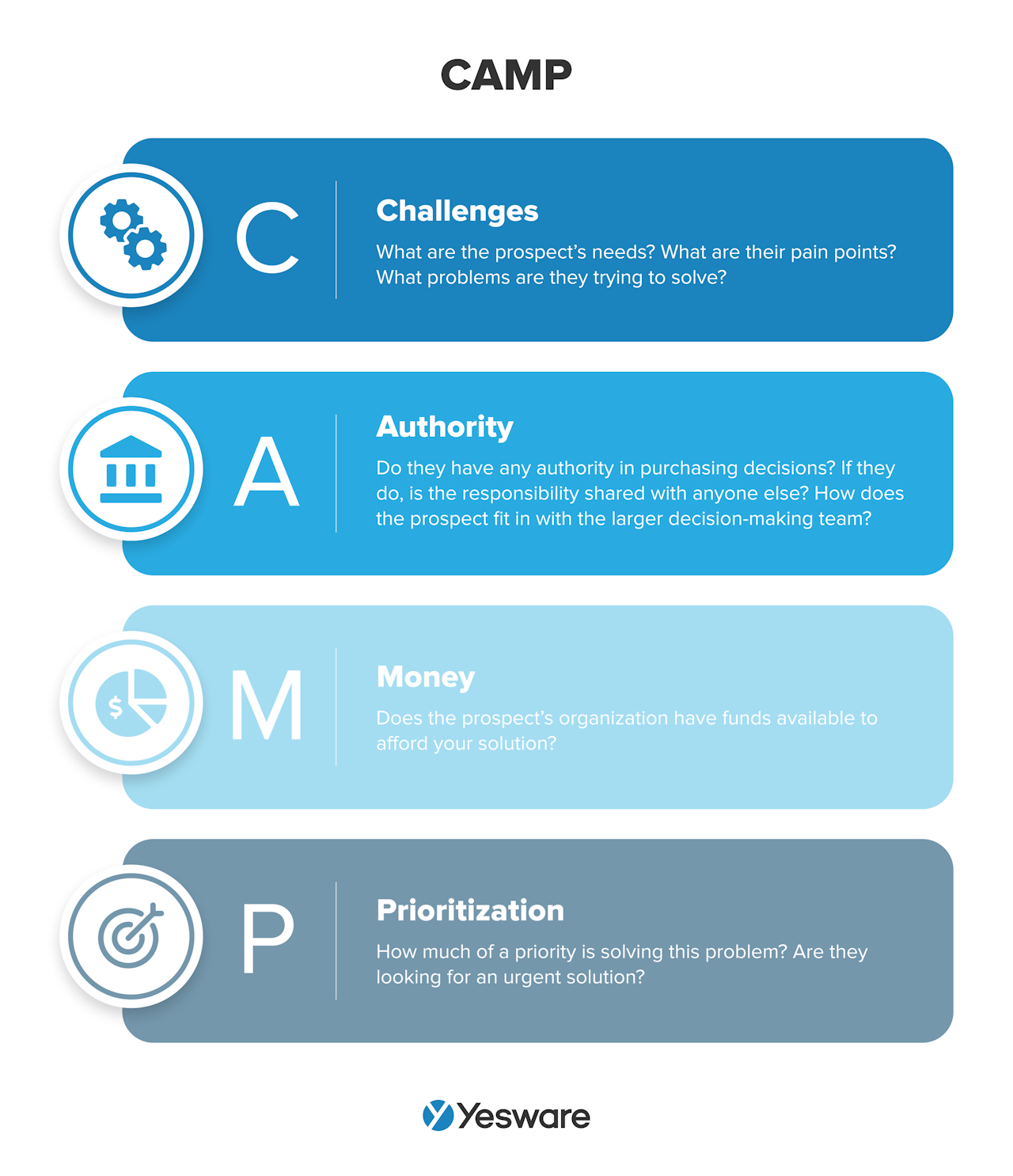 Here’s the CHAMP acronym broken down:
Here’s the CHAMP acronym broken down:
- Challenges: What is the prospect’s need? What are their pain points? What problem are they trying to solve?
- Authority: Do they have any authority in purchasing decisions? If they do, is the responsibility shared with anyone else? How does the prospect fit in with the larger decision-making team?
- Money: Does the prospect’s organization have funds available to afford your solution?
- Prioritization: How much of a priority is solving this problem? Are they looking for an urgent solution?
The CHAMP framework is particularly effective for prospects who are in a hurry to solve their problem. That’s why it focuses on pain and need first — this agitates the prospect into moving swiftly through the rest of the funnel to find relief with your solution.
FAINT
The FAINT framework was designed with a specific type of buyer in mind: those who aren’t necessarily planning to make a purchase, but have the ability to pull the trigger for the right offer. 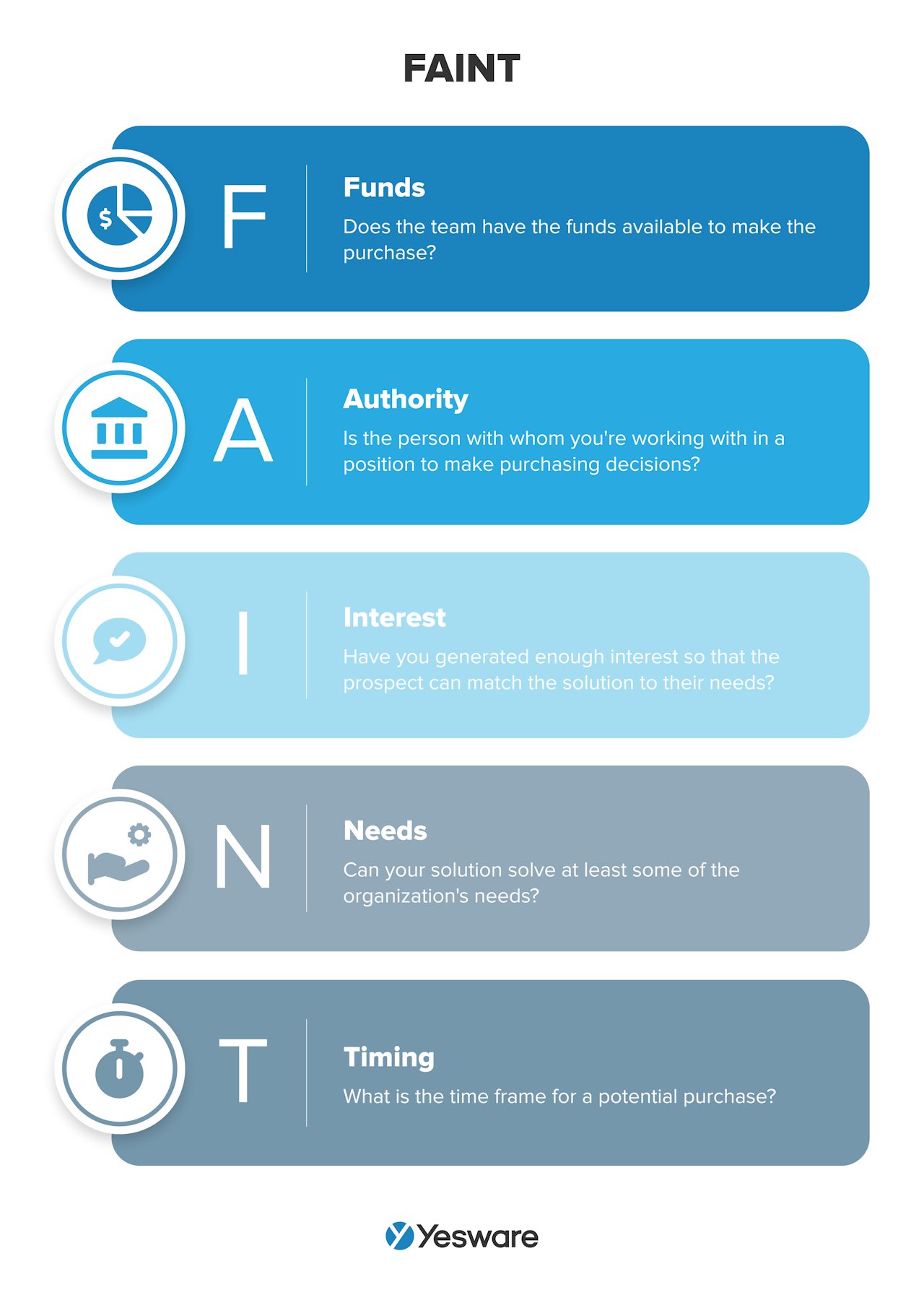 Here’s the FAINT acronym broken down:
Here’s the FAINT acronym broken down:
- Funds: Does the team have the funds available to make a purchase today, if it came down to that? The FAINT framework helps sellers identify which potential buyers have big budgets very early on in the process so that they can prioritize those who can financially pull the trigger if they feel compelled enough.
- Authority: The next most important criteria when it comes to big-ticket purchases is decision-making power. Once sellers feel confident that a buyer has the funds necessary to potentially purchase, they need to also understand whether the person with whom they’re working is in a position to make purchasing decisions. Prospects who answer “yes” to the first two domains are very promising leads for FAINT sellers.
- Interest: With budget and power identified, it’s now time for sales reps to gauge interest in the product. Note that interest actually comes before need in this framework. It’s up to the sales rep to generate interest in this stage with enough enthusiasm that prospects can match the solution to one of their needs.
- Needs: Interestingly, need is the penultimate criteria in the FAINT framework. That’s because, for these buyers, need is less of a concern than funds and interest. The product should, of course, meet at least some of the organization’s needs — but that isn’t the primary objective.
- Timing: With that idea in mind, timing is the last factor considered in the FAINT lead qualification framework. These buyers have the budget to make impulse purchases, so they don’t have to wait to raise more funds or to get financial approval.
The FAINT framework is perfect for markets with lots of unplanned buyers.
ANUM
The ANUM framework is similar to BANT but reprioritizes the criteria. 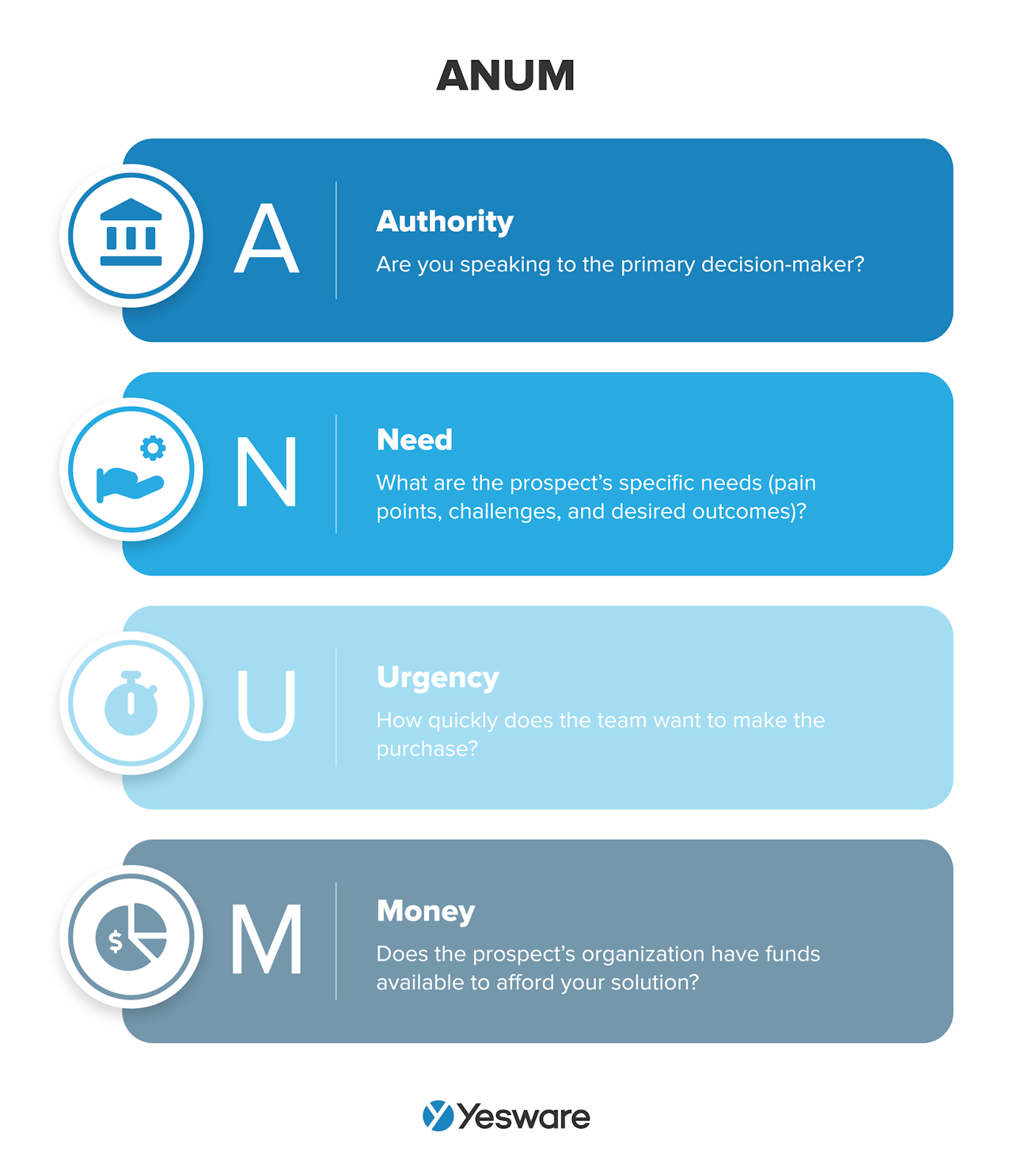 Here’s the ANUM acronym broken down:
Here’s the ANUM acronym broken down:
- Authority: The first priority in the ANUM framework is buying authority. Sales reps who use this framework aim to identify and connect with the primary decision-makers as soon as possible.
- Need: Next, these sellers learn more about the prospect’s needs. They learn more about pain points, challenges, and desired outcomes.
- Urgency: It’s then up to sales reps to understand the prospect’s timeline, and whether or not they can fulfill it in a way that meets their needs.
- Money: The last factor in the ANUM framework is budget. Sales reps work to ensure all other criteria are a good fit before discussing dollar figures.
The ANUM framework is very effective for buyers with very complex decision-making processes or otherwise long sales cycles. It’s also good for those who sell to enterprise companies, who presumably have the funds for bigger purchases but care more about finding the right fit.
GCPTBA/C&I
One of the more recent additions to the lead qualification framework group is GCPTBA/C&I. As evidenced by the fact that the acronym contains nearly a third of the alphabet, the framework is extremely thorough. 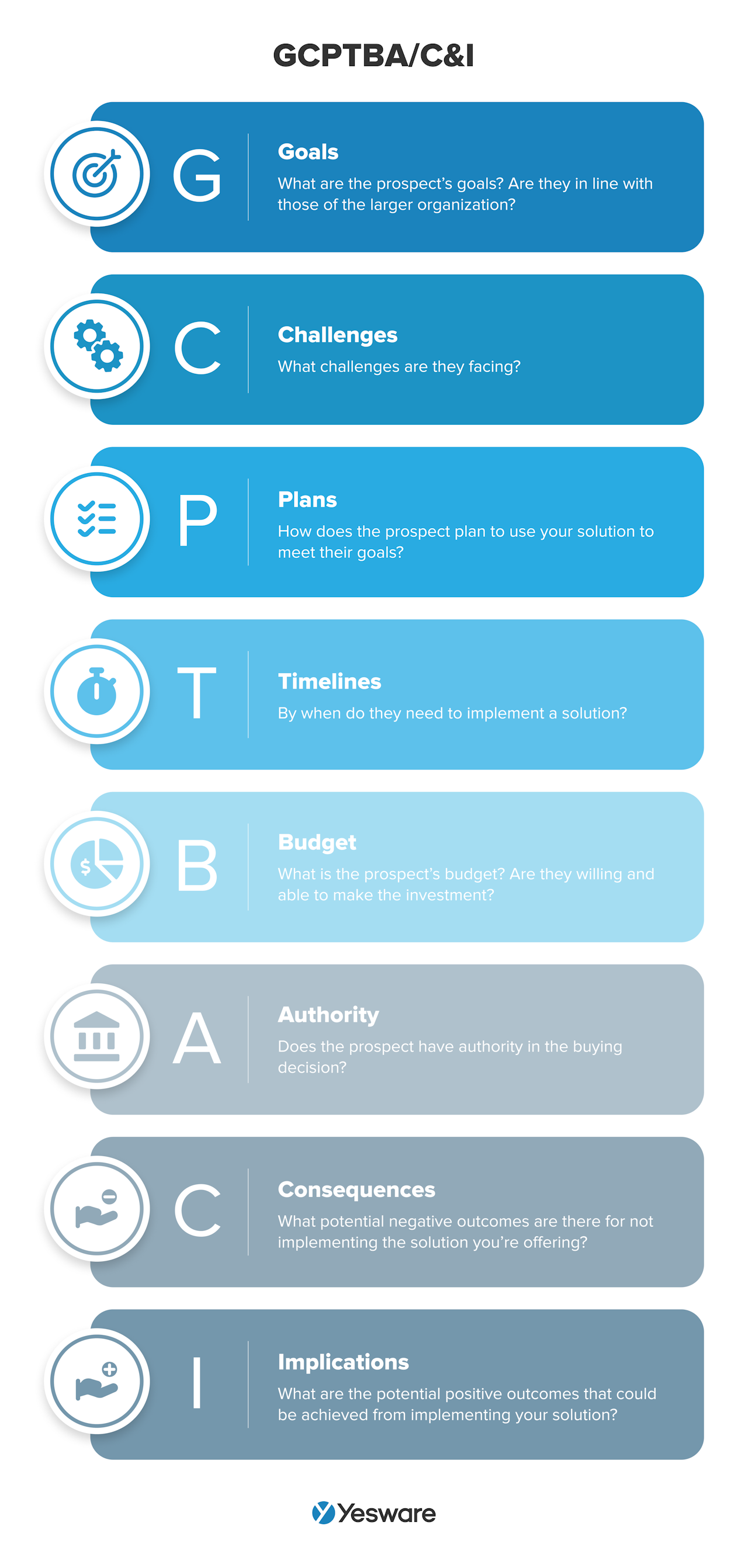 Here’s the GCPTBA/C&I acronym broken down:
Here’s the GCPTBA/C&I acronym broken down:
- Goals: What are the prospect’s goals? Are they in line with those of the larger organization?
- Challenges: What challenges are they facing?
- Plans: How does the prospect plan to use your solution to meet their goals?
- Timelines: By when do they need to implement a solution?
- Budget: What is the prospect’s budget? Are they willing and able to make the investment?
- Authority: Does the prospect have authority in the buying decision?
- Consequences: What potential negative outcomes are there for not implementing the solution you’re offering?
- Implications: What are the potential positive outcomes that could be achieved from implementing your solution?
As you can imagine, following the GCPTBA/C&I framework requires a lot of time. Not every prospect will have the patience to “hang in there” for this entire conversation in one sitting, so be mindful of your audience when you’re trying this out. That being said, it can be extremely effective at helping reps qualify and prioritize leads, which can lead to improved conversion rates.
Have you used BANT before? How did it go for you/your team? How could you adapt it to use in 2023?
This guide was updated on May 31, 2023.
Get sales tips and strategies delivered straight to your inbox.
Yesware will help you generate more sales right from your inbox. Try our Outlook add-on or Gmail Chrome extension for free, forever!
Related Articles
Casey O'Connor
Melissa Williams
Anya Vitko
Sales, deal management, and communication tips for your inbox
![Is BANT Still Effective in 2023? [Pros, Cons, Alternatives]](/blog/_next/image/?url=https%3A%2F%2Fwww.yesware.com%2Fwp-content%2Fuploads%2F2023%2F05%2FBANT-cover-2-yesware.jpg&w=1984&q=75)
